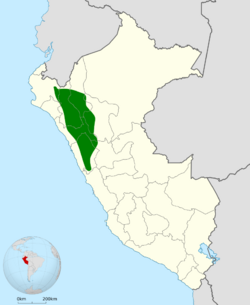Biology:Spot-throated hummingbird
| Spot-throated hummingbird | |
|---|---|

| |
| Scientific classification | |
| Domain: | Eukaryota |
| Kingdom: | Animalia |
| Phylum: | Chordata |
| Class: | Aves |
| Clade: | Strisores |
| Order: | Apodiformes |
| Family: | Trochilidae |
| Genus: | Thaumasius |
| Species: | T. taczanowskii
|
| Binomial name | |
| Thaumasius taczanowskii Sclater, PL, 1879
| |

| |
| Synonyms | |
|
Leucippus taczanowskii[2] | |
The spot-throated hummingbird (Thaumasius taczanowskii) is a species of hummingbird in the "emeralds", tribe Trochilini of subfamily Trochilinae. It is endemic to Peru but there are uncorroborated sightings in Ecuador.[3][2][4]
Taxonomy and systematics
The spot-throated hummingbird was formerly placed in the genus Leucippus. A molecular phylogenetic study published in 2014 found that Leucippus was polyphyletic.[5] To resolve the polyphyly the spot-throated hummingbird and the Tumbes hummingbird (Thaumasius baeri) were moved by most taxonomic systems to the resurrected genus Thaumasius. However, BirdLife International's Handbook of the Birds of the World retains it in Leucippus.[6][3][7][8][2]
The spot-throated hummingbird is monotypic.[3]
Description
The spot-throated hummingbird is 11.5 to 12.5 cm (4.5 to 4.9 in) long and weighs about 6 to 7 g (0.21 to 0.25 oz). The sexes are essentially alike. They have a somewhat decurved black bill, though sometimes the mandible is gray-brown or even yellow with a black tip. Their upperparts are grayish green to bronze green with a bronze crown and uppertail coverts. Their inner tail feathers are grayish green to bronze green that progresses to grayish on the outer ones, which also have a bronze band near the end. Their underparts are drab gray with golden green speckles on the chin, throat, and flanks. The undertail coverts have pale brown centers and whitish edges.[9]
Distribution and habitat
The spot-throated hummingbird is generally considered to occur only in Peru, on the west slope of the Andes and the Marañon River valley from near the Ecuadorean border south to Ancash Department. Undocumented sight records in far southern Ecuador lead the South American Classification Committee of the American Ornithological Society to list it as hypothetical in that country.[9][4] It inhabits arid scrublands and the edges of deciduous forest. In elevation in the Andes it mostly occurs between 900 and 1,900 m (3,000 and 6,200 ft) but is found locally as low as 200 m (660 ft). In the Marañon valley it occurs between 350 and 2,800 m (1,100 and 9,200 ft).[9]
Behavior
Movement
The movements of the spot-throated hummingbird, if any, have not been documented.[9]
Feeding
The spot-throated hummingbird forages for nectar from the understory to the mid-strata. Though details of the flowering plants it favors are lacking, it is known to feed at Inga trees, Agave, and banana (Musa). In addition to nectar, it feeds on small arthropods caught on the wing.[9]
Breeding
The spot-throated hummingbird's breeding phenology and nest have not been described.[9]
Vocalization
The spot-throated hummingbird's song is "a complex series of chips and wheezing electric warbles." It also makes "a dry chatter and tip notes."[9]
Status
The IUCN has assessed the spot-throated hummingbird as being of Least Concern. It has a fairly large range but its population size and trend are unknown. No immediate threats have been identified.[10] It is considered fairly common, and "[h]uman activity has little effect on Spot-throated Hummingbird, at least in the short term".[9]
References
- ↑ "Appendices | CITES". https://cites.org/eng/app/appendices.php.
- ↑ 2.0 2.1 2.2 HBW and BirdLife International (2021) Handbook of the Birds of the World and BirdLife International digital checklist of the birds of the world. Version 6. Available at: http://datazone.birdlife.org/userfiles/file/Species/Taxonomy/HBW-BirdLife_Checklist_v6_Dec21.zip retrieved August 7, 2022
- ↑ 3.0 3.1 3.2 "Hummingbirds". August 2022. https://www.worldbirdnames.org/new/bow/hummingbirds/.
- ↑ 4.0 4.1 Remsen, J. V., Jr., J. I. Areta, E. Bonaccorso, S. Claramunt, A. Jaramillo, D. F. Lane, J. F. Pacheco, M. B. Robbins, F. G. Stiles, and K. J. Zimmer. Version 24 July 2022. Species Lists of Birds for South American Countries and Territories. https://www.museum.lsu.edu/~Remsen/SACCCountryLists.htm retrieved July 24, 2022
- ↑ McGuire, J.; Witt, C.; Remsen, J.V.; Corl, A.; Rabosky, D.; Altshuler, D.; Dudley, R. (2014). "Molecular phylogenetics and the diversification of hummingbirds". Current Biology 24 (8): 910–916. doi:10.1016/j.cub.2014.03.016. PMID 24704078.
- ↑ Stiles, F.G.; Remsen, J.V. Jr.; Mcguire, J.A. (2017). "The generic classification of the Trochilini (Aves: Trochilidae): reconciling taxonomy with phylogeny". Zootaxa 4353 (3): 401–424. doi:10.11646/zootaxa.4353.3. PMID 29245495. https://www.researchgate.net/publication/321277435.
- ↑ Clements, J. F., T. S. Schulenberg, M. J. Iliff, S. M. Billerman, T. A. Fredericks, J. A. Gerbracht, D. Lepage, B. L. Sullivan, and C. L. Wood. 2021. The eBird/Clements checklist of Birds of the World: v2021. Downloaded from https://www.birds.cornell.edu/clementschecklist/download/ Retrieved August 25, 2021
- ↑ Remsen, J. V., Jr., J. I. Areta, E. Bonaccorso, S. Claramunt, A. Jaramillo, D. F. Lane, J. F. Pacheco, M. B. Robbins, F. G. Stiles, and K. J. Zimmer. Version 24 July 2022. A classification of the bird species of South America. American Ornithological Society. https://www.museum.lsu.edu/~Remsen/SACCBaseline.htm retrieved July 24, 2022
- ↑ 9.0 9.1 9.2 9.3 9.4 9.5 9.6 9.7 Schulenberg, T. S. and C. W. Sedgwick (2021). Spot-throated Hummingbird (Thaumasius taczanowskii), version 1.1. In Birds of the World (T. S. Schulenberg, Editor). Cornell Lab of Ornithology, Ithaca, NY, USA. https://doi.org/10.2173/bow.spthum2.01.1 retrieved September 3, 2022
- ↑ Cite error: Invalid
<ref>tag; no text was provided for refs namedIUCN
Wikidata ☰ Q1260889 entry
 |


